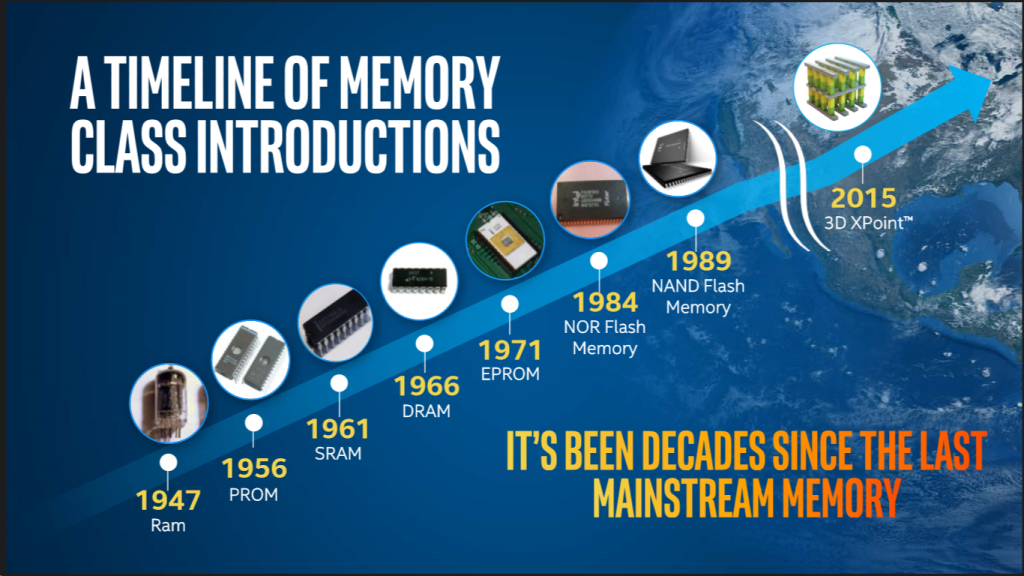Intel Corporation and Micron Technology, Inc., are announcing the first new memory category since NAND flash was introduced in 1989, revealing their 3D XPoint technology. This major breakthrough in memory process technology enables non-volatile memory speeds of up to 1,000 times faster than NAND!
Digital data services and connected device growth continues to explode, creating ever-more-massive new data amounts. This data is most useful when it can be stored, accessed and analyzed very quickly. This creates quite a challenge for system designers and builders, who need to achieve an appropriate balance between cost, power requirements, and performance. Tradeoffs are sometimes necessary when they design memory and storage systems. 3D XPoint technology is a combination of the performance, density, power, non-volatility and cost benefits of all available memory technologies on today’s market.
It has taken significant multi-year investments and hundreds of engineers to develop. However, their work has paid off since 3D XPoint offers speeds that are 1,000 times faster than NAND, with 1,000 times greater endurance, and has 10 times the density of conventional memory.
According to Rob Crooke, senior vice president and general manager of the Non-Volatile Memory Solutions Group at Intel, “For decades, the industry has searched for ways to reduce the lag time between the processor and data to allow much faster analysis. This new class of non-volatile memory achieves this goal and brings game-changing performance to memory and storage solutions.”
Mark Adams, president of Micron, observes that “One of the most significant hurdles in modern computing is the time it takes the processor to reach data on long-term storage. This new class of non-volatile memory is a revolutionary technology that allows for quick access to enormous data sets and enables entirely new applications.”
To demonstrate how our digital world continues to grow, we have gone from 4.4 zettabytes of digital data created in 2013 to an anticipated 44 zettabytes of digital data by the year 2020. 3D XPoint technology is able to turn this massive amount of data into useful and valuable information in just nanoseconds. For instance, retailers might use 3D XPoint technology to be able to detect and identify fraud patterns in financial transactions more quickly. Healthcare industry researchers would be able to process and analyze much larger data sets in real time, which would accelerate complex tasks like disease tracking and genetic analysis.
The PC experience could also be enhanced and benefit from 3D XPoint technology, with users able to enjoy faster interactive social media, collaboration, and even more immersive gaming experiences. 3D Xpoint’s non-volatile nature makes it an excellent choice for numerous low-latency storage applications, as the data is not erased when the device is powered off.
3D XPoint technology required more than a decade of research and development, and is built from the ground up to satisfy the need for non-volatile, high-performance, high-endurance, and high-capacity memory and storage, yet at an affordable cost. This new class of non-volatile memory greatly reduces latencies, permitting the storage of much more data close to the processor, and it is able to be accessed at speeds that were previously impossible.
Intel and Micron’s innovative, transistor-less cross point architecture creates a three-dimensional checkerboard, with memory cells residing at the intersection of word lines and bit lines, which permits the cells to be addressed individually. With this new technology, data can be read and written in small sizes, creating faster and more efficient read and write processes. In its current state it is at a 20nm lithography with a 128Gbit density and should not degrade in performance as it is scaled, unlike NAND.
 And just in case you are wondering, this memory is not going impact their 3D NAND road map in the foreseeable future. In terms of cost 3D XPoint memory is going to be between the cost of NAND and DRAM. Intel and Micron stated that 2016 will be the launch year for products and it will be sampling later this year with select customers. While Intel and Micron co-developed this technology, they will also be creating individual products. You can view the Intel press release announcing 3D XPoint technology in its entirety here.
And just in case you are wondering, this memory is not going impact their 3D NAND road map in the foreseeable future. In terms of cost 3D XPoint memory is going to be between the cost of NAND and DRAM. Intel and Micron stated that 2016 will be the launch year for products and it will be sampling later this year with select customers. While Intel and Micron co-developed this technology, they will also be creating individual products. You can view the Intel press release announcing 3D XPoint technology in its entirety here.
 The SSD Review The Worlds Dedicated SSD Education and Review Resource |
The SSD Review The Worlds Dedicated SSD Education and Review Resource | 

Now that’s interesting! Hope youi are enjoying the show in SanFran !
Sounds like some sort of amalgamation between dram & nand.
This is fantastic! Finally a paradigm shift in storage! Total game changer.
Some interesting theories are being trotted out as to what it is. Two good ones from EETimes and DailyTech. One speculates reRam, one speculates phase-change memory. Interesting arguments to support both theories. Hop on over to our forums, I started a discussion thread there with links to the two articles